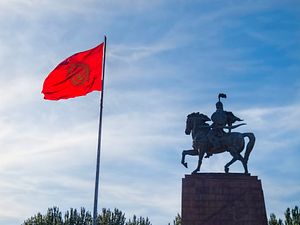This weekend’s recommended reads are all about Kyrgyzstan and its eminent parliamentary election:
Kyrgyzstan’s election on October 4 is, to say the least, incredibly important. There is both optimism that a well-executed election could reaffirm the democratic underpinnings of Kyrgyzstan’s government, and also pessimism that expectations are too high and potential flashpoints numerous.
Starting with a few splashes of cold water, Nate Schenkkan’s piece in Foreign Policy this week lays out very clearly the reasons to be less-than-optimistic about the election. Among several worrying issues, Schenkkan describes the parties as “essentially machines for patronage” and lacking actual platforms. Eurasianet tried decoding Kyrgyz party platforms last week, but prefaced the analysis with the comment that the party lists “create an impression that parties in Kyrgyzstan tend to be fragile coalitions of convenience that target a regionally divided electorate.” 24.kg commented two weeks before the election that “not all parties have finished their election programs.” I chimed in, noting as others have, that the election has prompted some odd mergers and that personality seems to supersede policy platforms.
A additional area of concern is the process of the election itself. In order to vote, Kyrgyz citizens have to have registered their biometrics (fingerprint, photo, signature) with the government. While the law mandating the biometric registration was upheld in Kyrgyzstan’s Supreme Court, it was upheld after the original judge was thrown off the court. Beyond concerns of constitutionality, data privacy, and disenfranchisement of migrant workers, there’s the simple possibility that the technology will not work as planned on election day. It is not clear that the government has a contingency plan. But, as I noted in September, “In all likelihood, election day will be marked by some technical troubles, migrant workers won’t bother voting, and in the end a number of politicians will be disappointed. But a new parliament will be elected, and a new coalition formed — then comes the hard part: governing.”
This is something Bruce Pannier, who has been traveling Kyrgyzstan covering the election for RFE/RL, also noted, “Simply put, if the people feel let down after all this excitement and effort, there are going to be problems.”
And there has been a great deal of excitement from some quarters. Pannier’s dispatches from the campaign trail are invaluable; he’s been in Naryn, Talas, Osh, Jalal-Abad, villages near the Tajik border, and Batken so far, talking to people about the election, seeing the visible signs of campaigning as well as some apathy. On the mountainous road to Talas, a shepherd moving his herd down from the summer pastures told Pannier, “I never vote. I’m busy.”
Erica Marat spoke to Schenkkan on his Central Asianist Podcast as the election campaign kicked off and today she has a piece in RFE/RL’s Qishloq Ovozi which displays a cautious optimism, or at the very least, a pragmatic view on the election. “Is Kyrgyzstan a democracy in the making?” she writes, “Without launching into a debate on definition of democracy, one can say that, at a minimum, Kyrgyzstan is not an autocracy.”
Additional reads: Anna Yalovkina on OpenDemocracy on a “gentleman’s agreement” between Kyrgyz parties not to report irregularities; a few more reports from Eurasianet on housing as a key campaign issue, accusations that the Social Democratic Party (the president’s former party) is using “administrative resources” to get ahead, and a piece on Kamchibek Tashiyev, a former boxer and the co-leader of Respublica-Ata Jurt who has been taken off the election lists after allegedly beating up a candidate from the Onuguu-Progress party.
































